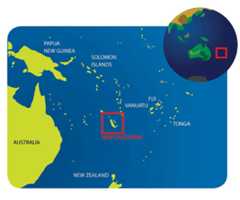


New Caledonia is located in the Pacific Ocean, some 1,200 km east of Australia and 1,500 km northwest of New Zealand. It consists of a main island, Grande Terre (16,000 km2), and several smaller sister-islands. The island group derives from the ancient supercontinent Gondwanaland (rather than being of volcanic origin) and is renowned for its striking flora and fauna, including many species that live nowhere else in the world.




One of the species unique to New Caledonia is the New Caledonian crow (Corvus moneduloides) which inhabits Grande Terre, and the nearby island Maré, where it is believed to have been introduced by man. Superficially, it looks similar to other crow species, including carrion crows (Corvus corone) which are also common in the UK. Likewise, their life stylejudging from our limited knowledge of wild crowsis that of a normal crow. Its sophisticated tool-oriented behaviour, however, clearly sets it apart from all other bird species, and even most primates.
 New Caledonian crows use tools to forage for invertebrates in dead wood. They use at least four different tool types (Hunt 1996, 2002, 2004a), including tools cut from the thorny edges of leaves ofPandanus trees. These tools are produced in a series of manufacturing steps and have complex shapes they are the most sophisticated animal tools yet discovered (Hunt 2000, 2004b).
New Caledonian crows use tools to forage for invertebrates in dead wood. They use at least four different tool types (Hunt 1996, 2002, 2004a), including tools cut from the thorny edges of leaves ofPandanus trees. These tools are produced in a series of manufacturing steps and have complex shapes they are the most sophisticated animal tools yet discovered (Hunt 2000, 2004b).



The shape ofPandanus tools varies regionally, and it has been suggested that this may be the result of cultural transmission of tool designs, with crows learning from relatives and other members of social groups how to manufacture and use particular designs (Hunt 2000, 2003). In other words, it is conceivable that these crows possess a culture of tool technology akin to that found in our own species.


Gavin Hunt and Russell Gray's web page on New Caledonian crows, Auckland University
Hunt, G.R. (1996). Manufacture and use of hook-tools by New Caledonian crows.Nature379: 249-251
Hunt, G.R. (2000). Human-like, population-level specialization in the manufacture of pandanus tools by New Caledonian crows Corvus moneduloides.Proceedings of the Royal Society of LondonB267: 403-413. DOI 10.1098/rspb.2000.1015
Hunt, G.R. (2000). Tool use by the New Caledonian crow Corvus moneduloides to obtain Cerambycidae from dead wood.Emu100: 109-114. DOI 10.1071/MU9852
Hunt, G.R., Corballis, M.C., & Gray, R.D. (2001). Laterality in tool manufacture by crows.Nature414: 707. DOI 10.1038/414707a
Hunt, G.R., & Gray, R.D. (2002). Species-wide manufacture of stick-type tools by New Caledonian Crows.Emu102: 349-353. DOI 10.1071/MU01056
Hunt, G.R., & Gray, R.D. (2003). Diversification and cumulative evolution in New Caledonian crow tool manufacture.Proceedings of the Royal Society of London B270: 867-874. DOI 10.1098/rspb.2002.2299
Hunt, G.R., & Gray, R.D. (2004). The crafting of hook tools by wild New Caledonian crows.Proceedings of the Royal Society of London B (Suppl.)271: S88-S90. Published online 30 October 2003, DOI 10.1098/rsbl.2003.0085
Hunt, G.R., & Gray, R.D. (2004). Direct observations of pandanus-tool manufacture and use by a New Caledonian crow (Corvus moneduloides).Animal Cognition7: 114-120. DOI10.1007/s10071-003-0200-0